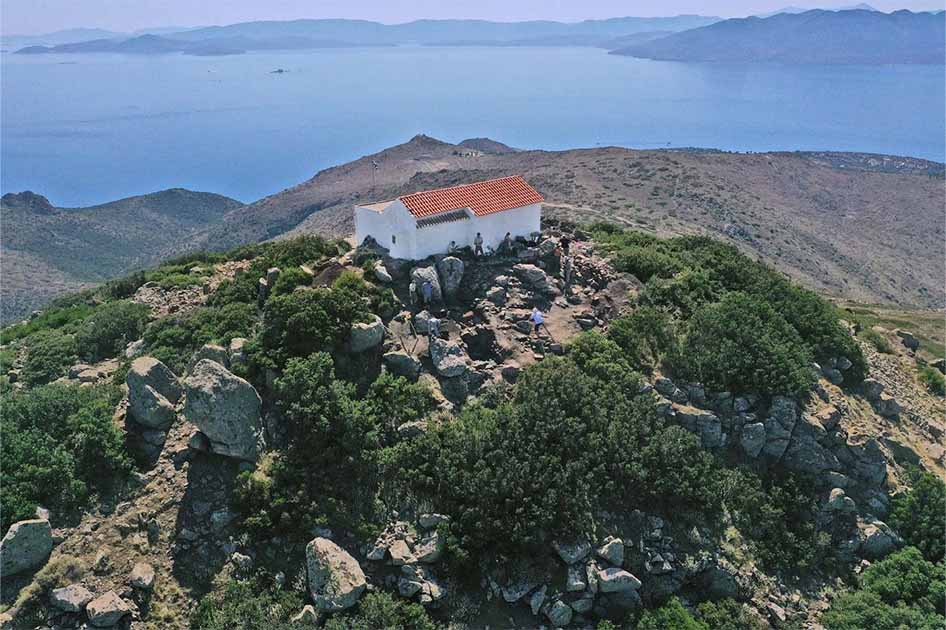Discoveries at Mt Ellanio Reveal Mycenean Refuge from the Bronze Age Collapse
An interdisciplinary team of archaeologists has been investigating the tallest mountain on the Greek island of Aegina since 2021: Mount Ellanio. Overlooking the Saronic Gulf, the peak holds the remnants of a 4th century Temple of Zeus Hellanios.
The mission, a Greek-Swiss partnership (EFAPN), is investigating the mountain’s prehistoric occupation, and have found a building measuring 4.5 by 3 meters (15 by 10 feet), containing an assortment of 30 ceramic vessels. What makes the building so special is that it is Mycenean.
Zeus on Ellanio: A Sanctuary and Safe Haven
The presence of Zeus worship on Mount Ellanio is documented in ancient texts like those of Pausanias. A chapel now stands atop these ancient foundations, but Corinthian clay tiles suggest an earlier structure beneath, likely a small temple.
- Discovery of Kouros Statues Puts Euromos Temple of Zeus Lepsynos on the Map
- Civilization's Midnight: The Late Bronze Age Collapse

Pottery found at the site is unmistakably Mycenean, showing that the site was used as a refuge by those fleeing the end of their world (Greek Ministry of Culture)
North of the chapel, sacrificial remnants in a black layer, along with countless charred animal bone fragments, unveil ancient rituals. The discovery of pottery spanning from the Geometric era to Roman times also underscore the sacred site’s continuity.
An analysis of the vessels' form and style helps trace their origins to the twilight and dying embers of the Mycenaean palatial era (the Late Bronze Age in Greece). This was a tumultuous epoch characterized by upheaval and disintegration of much of the ancient world, spanning the years from 1200 to 1050 BC, according to a press release by the Greek Ministry of Culture.
In the wake of this upheaval, mainland Greece witnessed a mass exodus, as waves of Mycenaean refugees sought solace in faraway lands, including Cyprus, the Levant, and neighboring Aegean islands. It was the end of Bronze Age Greece, and led to a Greek Dark Age lasting hundreds of years.
Aegina emerged as a sanctuary of respite amongst its mountainous contours, with survivors of the chaos seeking refuge amidst the sacred peaks. The fortified enclosure, consisting of retaining walls, ancient towers, and rock inscriptions, along with the dwellings at the summit, indicate the use of the hill as this refuge.
- Myrmidons: The Fiercely Loyal and Unstoppable ‘Antmen’ Army of Achilles
- Ancient Zeus Kasios Temple Unearthed In Egypt

Reconstructed finds from the Mycenean refuge in Mount Ellanio (Greek Ministry of Culture)
The terrain, now sparsely populated, bears abundant evidence of human activity from ancient times to the mid-20th century. Among its remnants are fortifications, terrace walls, an ancient tower, quarries, ancient rock inscriptions, livestock pens, cultivated fields, cisterns, deserted settlements, and even a legendary dragon cave!
Embedded within the earth, shells dating back to the Middle Bronze Age have also been found. This period, spanning the first half of the 2nd millennium BC, coincides with the zenith of Aegina's prominence as a bustling hub of commerce and maritime activity, reports LBV Magazine.
Earlier excavations conducted at the start of the 20th century complement the current research. The aim of this research of the peak is therefore twofold, encompassing both prehistoric epochs and the periods associated with the revered sanctuary of Zeus.
This has included the unearthing of a Mycenaean clay wheel-made figurine, now displayed at the Archaeological Museum of Kolona in Aegina. The figurine is a clear attestation to the mountain's veneration as a sacred space in the Bronze Age.
An Archaeological Island
The ongoing investigation is slated to continue for another two years as part of a planned five-year agenda. The addition of the sanctuary of Zeus adds a whole new layer of intrigue to the archaeology at the site. There are plans to make the island an archaeological expedition, encompassing the temples of Aphaia, Apollo at Kolona, and Mount Zeus, reports The Heritage Daily.
In 2023, EFAPN initiated a concerted endeavor aimed at accentuating, fortifying, and restoring the island's historic monuments. Commencing with the sanctuary of Apollo at the island's maritime gateway, efforts were directed towards bolstering the sole surviving column of the sanctuary. Concurrently, endeavors are underway to enhance the Archaeological Museum of Kolona, necessitating essential repair works.
At the revered Sanctuary of Aphaia, one of the most important of such places in antiquity and one which stands alongside the Parthenon and Sounio, the intent is to enhance the archaeological site with expansive renovations and enhancements to the temple.
A parallel endeavor is planned for the promotion of Mount Zeus, as archaeologists piece together this lost landscape and look to understand how the Bronze Age Collapse changed the world of ancient Greece. Plans include rendering the site accessible to the public, thereby fostering a deeper engagement with its rich historical legacy.
Top image: The summit of Mount Ellanio was used by Myceneans fleeing the Bronze Age collapse and used as a refuge. Source: Greek Ministry of Culture.
By Sahir Pandey
References
Carvajal, G. 2024. Excavations at Sanctuary of Zeus on Aegina’s Mount Hellanion Reveal it Was Used as Refuge During Destruction of Mycenaean Palaces. Available at: https://www.labrujulaverde.com/en/2024/04/excavations-at-sanctuary-of-zeus-on-aeginas-mount-hellanion-reveal-it-was-used-as-refuge-during-destruction-of-mycenaean-palaces/
Milligan, M. 2024. Excavations of Mount Ellanio summit reveals Mycenaean refuge. Available at: https://www.heritagedaily.com/2024/04/excavations-of-mount-ellanio-summit-reveals-mycenaean-refuge/151328
Radley, D. 2024. Archaeologists discover Mycenaean building and ceramics on Mount Ellanio, Aegina. Available at: https://archaeologymag.com/2024/04/mycenaean-building-and-ceramics-on-mount-ellanio-aegina/

















